When Diamond’s voluble CEO Christian Dries first flew the prototype diesel-powered twin that eventually became the DA42 in 2002, he said something he would later regret. The airplane would cruise at 200 knots on 10 to 12 GPH. The reality, of course, proved rather less. The DA42 was a strong seller, but a 200-knot cruiser it wasn’t. More like about 155 knots on real-world power settings, although the economy was certainly impressive.

A decade later, Dries and Diamond are at it again and this time, to quote another famous CEO, they think they’ve got the goods. The soon-to-be-introduced DA42 V1 includes a long menu of aerodynamic improvements that seem to substantially improve the aircraft’s climb rate, cruise speed and engine-out performance. Although our brief test flight didn’t hit the magic 200 knots, we saw speeds approaching that number.
When we visited Diamond’s factory in Wiener Neudstadt, Austria, in early March, the company was putting the finishing touches on the V1 and planning to show the certification-ready version at the Aero exposition in Friedrichschafen, Germany, in April. Furthermore, they were assembling yet another twin that will also appear at Aero, the DA52.
Long Road
Diamond’s road to the DA 41 V1 began with the Thielert-powered version announced in 2002 and certified in 2005. The airplane got rave reviews and enjoyed strong sales, but never performed quite up to Dries’ hopes. In 2008, the project began to unravel as field service problems with the Thielert diesel emerged and the engine maker filed for insolvency in mid-2008. Diamond had what can generously be described as a tense relationship with Thielert, so it launched its own company, Austro Engines AG, to develop, certify and build aerodiesel and gasoline engines.
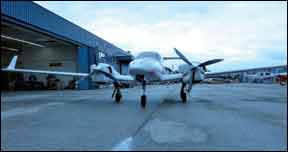
This yielded the AE300, which uses the same Mercedes-Benz core engine that Thielert used for its Centurion models but that retains the MB’s original cast-iron block rather than the aluminum-block conversion Thielert did. This decision has positives and negatives. The engines are likely to be more durable and are overhaulable, while the Thielerts have a TBR—time between replacement.
Austro stuck with the core block, heads and valve train of the original engine, but it engaged Bosch to set up a dedicated business unit to produce fuel injection systems for the AE300. Further, where the Theilert engines had gearboxes and clutches that proved somewhat tender, the Austro version has a dynamic torsional damper—essentially a couple of gears with a spring in between—to isolate the prop from the engine’s powerful torque kicks.
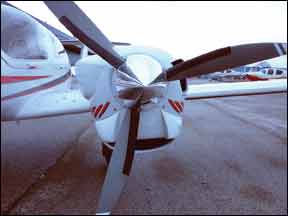
All very nice. But the Austros are quite a bit heavier than the Thielerts, about 112 pounds to be specific. To address that, Diamond simply certified the first airplane to carry the AE300, the DA42 NG, to a 245-pound higher weight, for a 4180-pound (1900 kg) gross weight. They’ve done the same thing on the new V1 version of this airplane. The original NG is a good performer, climbing at 1200 FPM on both engines at an 86-knot Vy. In cruise, we saw the NG turn in 167 knots TAS on 8.3 GPH per side. Not bad, but far off Dries’ 200-knot goal. Dialing it back a little yields 165 knots on 6.6 GPH per side.
While those numbers are certainly credible and they are better than the Thielert-powered airplanes, Diamond still wanted more, since it envisions its twins competing against the 200-knot Cirrus airplanes. Diamond’s Dries argues that a second engine is better than a parachute, but so far, the market hasn’t taken up that cry with much enthusiasm.
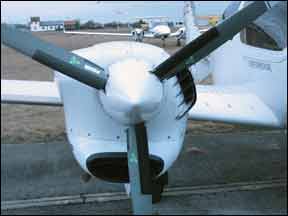
V1
We’re not sure why Diamond elected to call the new airplane the V1, given the probability of buzz bomb jokes that might not play we’ll in the UK, but naming airplanes isn’t exactly a science. When we toured Diamond’s factory in early March, the V1 was in the final phase of testing. Diamond’s managing director, Michael Feinig, told us what governed V1 development wasn’t “one thing, but one knot.” The company made a number of minor aerodynamic changes that appear to add up to substantially higher cruise speed and climb and better engine-out performance, especially at high altitude.
Chief test pilot Ingmar Mayerbuch ran us through the list. If there was low-hanging fruit here, it appears to be nipping a lot of cooling drag. “One big part of the drag reduction was to reduce the cooling drag of the engines,” Mayerbuch told us. “We achieved that by rearranging almost every component in the engine compartment. The outer cowling was also modified so, in the end, we had better cooling efficiency of every component.” The intercoolers, water and oil coolers and the inlet ducting were all substantially redesigned.
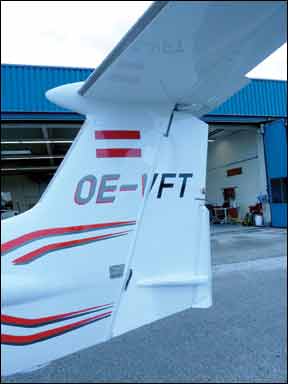
Only a practiced eye would see the differences, but if the airplanes are viewed side by side, they are quite obvious, especially the cowlings. The V1’s lower inlets are smaller and reshaped, as is the side inlet. The cowling still has the large bump to accommodate the turbocharger, but the grillwork outlet in the rear has been modified and looks both smaller and less complex than on the previous twin.
The airframe was also modified, with most of the attention given to a redesign of the rudder. The old rudder had a lower counterweight arrangement, but the new one does away with that in favor of a smaller rudder hinged on the vertical stab, which has itself been redesigned. The new rudder has no projection below its hinge line and is fit more tightly into the redesigned vertical fin to reduce drag. Belly strakes in front of the rudder have been removed. The landing gear has also been reworked, including the doors, further reducing drag.
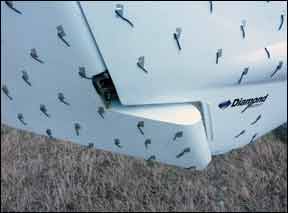
Mayerbuch told us the goal of the rudder work was to reduce the takeoff roll and improve engine-out performance. We weren’t able to measure it, but Diamond says gross weight takeoff roll has been reduced by about 300 feet over the standard DA42. Minimum controllable airspeed has also been reduced, thanks to the improved tail. Diamond claims an 8-knot reduction to 67 knots at full flaps.
Touring the outside of the airplane, the V1 has numerous other drag clean up features you might not notice unless they were pointed out. For instance, the TKS membranes are much more smoothly faired into the leading edges, there are fairings on the flap hinges and even the angle of incidence of the cabin step has been changed to reduce drag. The balance point of the ailerons was moved inboard to yield a better fit and some 300 screws and fasteners have converted to flush heads.
Much of the improved performance comes from the engines and props. MT designed a new three-blade scimitar profile for the V1 and through improved intercooling to remove temperature limits and the elimination of previous RPM limits (from 2100 to 2300 RPM), the engines have considerably better performance, especially at altitude. (The new single-engine ceiling is 18,000 feet.)
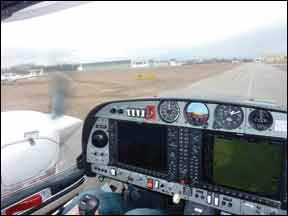
The V1 retains the same gross weight as the NG, namely 4180 pounds with an empty weight of 3146 pounds (1430 kg) for a useful load of 1034 pounds (470 kg). Diamond put the airplane on a two-phase weight reduction program that eliminated up to 66 pounds (30 kg) in composite and interior weight.
Does It All Work?
We flew with Ingmar Mayerbuch on an absolutely nasty late winter Austrian day, with gusty winds, a low broken ceiling and light rain. The ceiling was broken enough to find some holes to spiral up through, since the airplane wasn’t yet approved for IFR.
Starting the Austros, as with the Thielerts, is automotive like. Just turn on the masters and crank them; there’s obviously no mixture to deal with, since the engines are fully managed by FADECs, including the props. For the V1, Diamond retained the auto-test of the ECUs. This involves simply pushing and holding a pair of momentary buttons, which automatically runs the engines and controls through pre-takeoff diagnostics. There are also switches labeled “voter” that allow the pilot to manually select an individual ECU channel to test its function.
What’s immediately noticeable about the Austro engines is how perceptively smooth they are. You see and hear them running, but you can’t feel them. Diamond’s Feinig told us he thinks this is due to the Austro torsional damper and it may very we’ll be. The Thielert engines seem nearly as smooth, but both have far less buzz than the Lycoming engines that are used in the same aircraft.
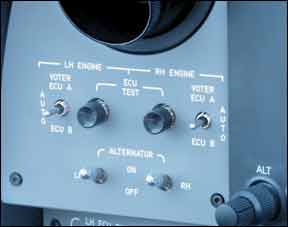
Prior to our flight, Mayerbuch promised we would see about 300 FPM better climb, about 150 FPM improved single-engine climb rate and a whopping 15 knots of additional cruise speed. Those are tall claims and big improvements for an airplane that essentially has the same power as what went before it.
Did it deliver? We’ll have to qualify our answer by saying our flight was brief and conditions weren’t the best, with turbulence and rain, so we’ll reserve our final judgment until we’ve had an opportunity to take a longer flight in better weather. On initial climbout, we saw between 1300 and 1400 FPM on two engines, which is 200 FPM better than the NG model we flew in 2009. The V1 holds a strong climb rate we’ll into the teens, where it will be quite happy at 16,000 feet. The previous version was more constrained to lower altitudes and thus we didn’t see anything like the cruise numbers the V1 appears capable of.
Leveled out in smooth air at 16,000 briefly, we recorded 194 knots TAS on 8.3 GPH per side, which is about 90 percent power. Throttled back to a more realistic 70 percent, the airspeed drops to about 174 knots on around 6 gallons per side. That’s where we suspect most owners will operate this airplane, so it’s still not quite the 200-knot cruiser once hoped for, although it appears to be at least 15 knots faster than the first Austro-engined version and perhaps 20 to 25 knots faster than the first Thielert-powered airplanes.
Engine-out performance is excellent, especially at high altitude. When we reached 14,000 feet, Mayerbuch shut down the right engine and the V1 had no trouble maintaining a 250-to-300 FPM climb on the right engine, at a weight about 100 pounds below gross.
Of course, all of this comes at a price. The V1’s suggested retail price is $770,000, equipped with TKS, the Garmin G1000 and the GFC700 autopilot. It was expected to be certified by mid-April. On a future date, we’ll take a closer look at the airplane. For the time being, call us conditionally impressed.


